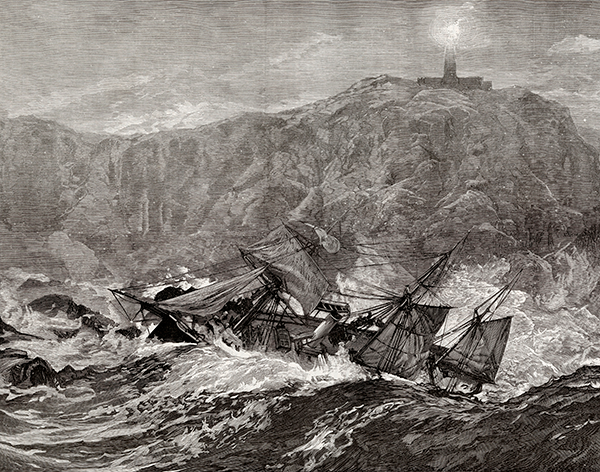The wreck of HMS Wasp, 1884
Published in Issue 4 (July/August 2021), News, Volume 29By Tom Sigafoos
On 22 September 1884, HMS Wasp, a Banterer-class gunboat of the Royal Navy, ran onto the rocks at the foot of the Tory Island lighthouse, broke apart and sank a few minutes before 4 a.m. Forty-six crewmen and four officers drowned. Five men scrambled up the mast and dropped to safety on land when the ship keeled over, and the cook, the oldest crew member, survived after being washed ashore.
The Wasp had been ordered to sail to Moville to assist the sheriff and deputies in forcibly evacuating Inishtrahull Island (north of Malin Head). At the time of the wreck, the ship was running under sail with an inexperienced young officer at the wheel. The engine-room fires had been banked, so there was insufficient boiler pressure to manoeuvre off the rocks. A formal court-martial dismissed the event as ‘navigational error’, and the records of the inquiry have disappeared.
According to legend, the Wasp had been en route to evict Tory Island residents, but the islanders ‘turned’ a cursing stone and the ship sank in a calm, sunlit sea. Some claimed that the curse lingered for more than a hundred years, when a reality-television-show sailing yacht foundered in an eerie coincidence on the Tory rocks.
I have written The cursing stone, a novel about the shipwreck of HMS Wasp. Books, newspaper articles and an earlier novel have been written to try to account for the disaster, but they pose more questions than they answer. Even in those pre-radar days, what combination of circumstances could lead a Royal Navy gunboat to navigate onto the rocks at the foot of a lighthouse whose beams could be seen for sixteen miles? Was there sabotage? Or a mutiny?
For information about the Wasp and Tory Island, the research desk of the Letterkenny Library offered a substantial collection of printed materials and microfilm files. My favourite source of information was Stories from Tory Island, a book by Dorothy Harrison Therman. Oral histories can be tiresome to read if quoted narratives are printed in long, uninviting blocks of text, but Ms Therman brought the Tory stories to life by breaking them into short lines and phrases that read like poetry.

Above: The wreck of HMS Wasp, as depicted in the Illustrated London News. (Mary Evans Picture Library)
When Monica Corish and I visited the island, Patsy Dan Rodgers, then King of Tory, spent hours with us recounting the stories that surrounded the sinking of the Wasp. Artist, raconteur and tireless promoter of the Tory Island community, his death in 2018 was a profound loss to everyone who knew him. Also on Tory, Father John Boyce shared his time generously, providing insights into the long-standing tensions between Celtic Christianity and Roman Catholic doctrine. When we visited the Baily Lighthouse Museum at Howth, Frank Pelly and Captain Owen Deignan organised an extended tour and shared their insights into ‘the life on the lights’ in detail.
Since 1884, the seanchaí of Tory Island (who have a long-standing reputation for ‘brave’ storytelling) have filled in the gaps in the story of the Wasp with an Irish stew of speculations and surmises. My novel The cursing stone is another addition to that concoction. I have attempted to match the events of the novel generally with the events, ships and lighthouse systems of 1884. As historical fiction, I hope that it whets the appetites of a new generation of readers to learn more about the era of the Land War and the resilient people who have thrived on the islands of Ireland.
After the shipwreck of the Wasp, legend had it that the Tory priest cast the cursing stone into the sea. When Monica and I visited Tory, however, a number of people assured us that the old totem remains hidden on the island. No two islanders suggested the same location, but everyone agreed that the stone has a blood-red streak in its heart.
Tom Sigafoos is an Irish-American writer, editor and writing coach, and PRO for the Allingham Arts Association, Ballyshannon.
The cursing stone is available in serial form at no cost from www.tomsigafoos.com, tomsigafoos@gmail.com.
















